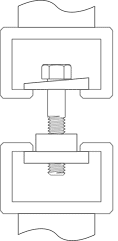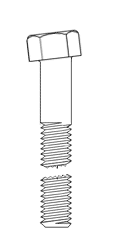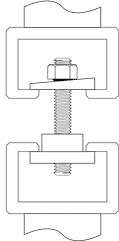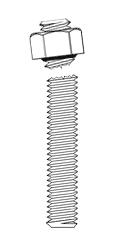When a threaded rod with a nut is substituted for a bolt with a forged head, two issues come into play. When in-house mechanical testing was performed by Portland Bolt on headed bolts versus rods with a nut, both from the identical lots of steel, the rod with a nut developed up to 12% less strength than the comparable headed bolt. The reason for this reduction in strength on the rod with nut is that the stress area at the junction of the rod and nut (which is substituting for the forged bolt head) is significantly reduced. Because the minor diameter (root) of the threads is significantly less than the full-size diameter of the unthreaded shank on a headed bolt, the rod with nut often breaks at a much lower strength than a headed bolt. More importantly, even if the rod with nut does develop enough strength to meet the specification, it will often break at the junction of the nut which is acting as the head of the bolt when wedge tested per ASTM F606. For this reason, technically a rod with a nut in lieu of a headed bolt will frequently fail mechanical testing because the head (nut in this case) comes off before the bolt breaks in the body or threaded section of the fastener which constitutes an automatic failure.
We often see fastener distributors and manufacturers without forging capabilities talking customers into switching from a headed bolt to a rod with a nut since they are unable to provide the forged product that was engineered into the structure. We see this most frequently with regard to headed anchor bolts. Making the decision to switch from a bolt with a forged head to a rod with a nut should always be approved the Engineer of Record to prevent any liability in making such a substitution should a failure of the fasteners occur.
Wedge Testing per ASTM F606




Note: Wedge testing as shown above is required to obtain mechanical properties for most ASTM high strength fasteners. A greater difference was found for high-strength fasteners than mild steel fasteners during Portland Bolt in-house testing of headed bolts versus rods with a nut. The reduced cross-sectional area at the junction of the nut as compared to a bolt with a forged head caused the fasteners with a nut acting as a bolt head to break at lower strengths than the bolts with forged heads. Additionally, the high strength rods with a nut acting as a head broke just below the nut which would automatically constitute a failure since the wedge test requires the bolt to break either in the body of the bolt or in the threaded portion, not at the junction of the head.
These comments seem to refer to static strength, fatigue might be more important. The stud will have more elastic stretch energy so will lose less load with time and it also does not have the small rad under the bolt head to provide a fatigue start point.
Whatever is the right answer it is good to see a bolting company providing an area for customers to comment and share ideas.
It appears that the test with a wedge induces a moment on the bolt that hastens failure as opposed to a straight tensile pull. AISC formulas account for the root diameter so it seems that when one specifies a threaded rod we would get the published capacities in straight tension with a threaded rod. Is this test applicable to to how we load an embedded anchor?
@Landon- The wedge under the head does not hasten failure, it simply acts to evaluate the integrity of the head and the ductility of the material. The bolts should fracture at the same point and in the threads regardless of whether they are tested with or without a wedge. Now, if we were testing a threaded rod without a head, then the wedge would hasten failure, but those are instead tested without a wedge.
I would like to see the math on this. In the comments, it appears that the headed bolt and the threaded rod were compared using nominal specifications, e.g. a three-quarter inch bolt vs. three-quarter inch threaded rod.
But, what is the comparison in psi?
*
This article shows that it is an error to simply replace a specified headed bolt with threaded rod of the same nominal diameter. The article also says a change must be engineer approved.
*
What I want to know is this: If a contractor prefers working with threaded rod, what adjustments do I make?
@Robert- We no longer have those specific test results, as they were performed many years ago. What we are trying to do in this article is to highlight our heading capabilities and simply let the end user know that if the engineer has specified headed bolts, they should use caution before simply substituting a threaded rod, as it is not necessarily equal. As for your last question, it depends. If the bolt is in shear or straight tension, the difference between the headed bolt and the rod may be negligible. However if there are angled or moment forces at play, the headed bolt will be superior and if you’d like to substitute a rod, you may need to play with the design to make sure you don’t get yourself in trouble.
What about the exposed end of an anchor rod at the base plate? Why would a plate washer and nut at the embedded end be any diiferent?
@David Sammons- The testing we performed was in the lab as per ASTM F606. In an actual end use application embedded in concrete, we do not have any test data to reference.
Can you tell me the shear strength of threaded rod with a nut. I have job that is attaching anchors in trees. The spec calls for threaded rod so that the tree will grow around the rod. I need to attach fixtures that will hang on the rods. I need a 10,000 lbs shear. The hanger will have a 1/2 ” sleeve around the rod with a walsh against the tree and the hanger against the washer, tightened with a washer, and lock nut.
Thanks
@Steve- It will depend which grade of all thread you are using. Assuming A307A mild steel, you would need 3/4-10 all thread rod to achieve 10,000lbs of shear. If you were to move up to A193B7 all thread rod, you could reduce your diameter to 1/2-13.